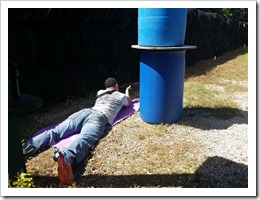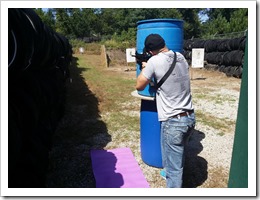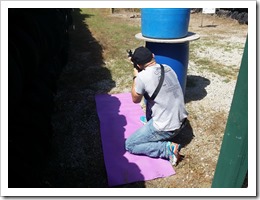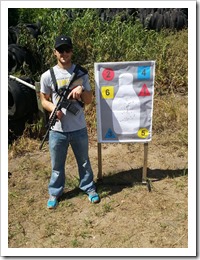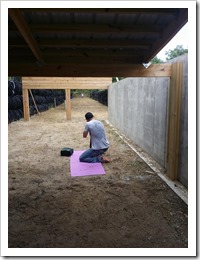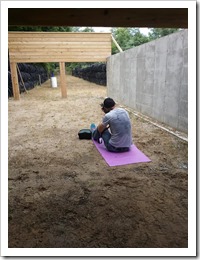I’ve seen this discussion pop up for years and years and . . . well, you get the idea – for as long as there have been handguns for personal defense – the argument over what the ‘Best” caliber and what the “Best” gun has been on the lips of many an expert.
Let’s set the context of the argument first. As a defensive firearms trainer, folks that come to me for training come for that specific focus – defensive shooting. They are asking me (and all defensive fire arms trainers as well) a profoundly important question . . . “What is the best weapon I can use to defend my life?” That’s a pretty weighty question. They deserve so much more than many of the canned answers out there . . .
“Can’t ever go wrong with a Glock!”
“Nothin’ better that a good old 1911!”
“I think this little pink 380 would do a great job for you!!”
Or the 5’ nothing, 100 lb woman being handed “The Judge” by the sales clerk with the words “Hell, just point this thing at them and they’ll haul ass!”
There are a lot of people who have gotten some truly poor advice – typically given through laziness, ignorance or simply the desire to “make the sale”. Let’s spend some time on this topic.
Use of your defensive weapon.
First, let’s look at why, exactly, you carry a defensive weapon. Its purpose is to defend your life, the lives of your family or folks in your charge . . . TO. DEFEND.THEIR.LIVES. ponder that thought just a bit. It’s not to make holes in paper, for entertainment on a range, for the enjoyment you get from taking challenging training, for hunting. At the instant you draw your weapon from its concealed location – you will either win the engagement – or go home in a ZipLoc. Once drawn – it is life and death. Take some time to chew on that just a bit because the intensity, the “stakes” of that moment are seldom part of the overall discussion.
Control of your defensive weapon.
In order to be effective in your defense – you must be able to control and manipulate your weapon. If you are unable to get “combat effective hits” (each “hit” does real damage to the threat’s ability to continue their attack) – your weapon is of little value. If you are unfamiliar with how your weapon works – your weapon is of little value. If you can only control you weapon through the first round – and are then unable to manage its recoil and rapidly get back on the threat – your weapon is of little value. If you experience a misfire, a failure to feed, a failure to eject, a double feed – and you are unable to clear these issues quickly – your weapon is of little value to you.
Bottom line – if you cannot use the tool you carry with you each and every day that you depend on defend your life, well – your weapon is of little value to you.
So let’s start there – with YOU – as we begin the examination of which is the BEST gun for you to use for your personal defense and which is the BEST caliber to use.
A quick story – I’d just gotten a call from my FFL that my Ruger LC9 had finally arrived. I had anxiously awaited its arrival as this was to be my new carry weapon. (long since relegated to a classroom demo gun – I’ve returned to by Glock 17 as my EDC gun – but that’s another story) A mutual friend of the FFL and me happen to be there as I opened the box for an examination – we’ll call him “Tom”. Tom is an older gent – late 70s but at that time quite an active guy helping the FFL at gun shows, golfing regularly showing little in the way of reduced mobility with his age. He had been looking for a new gun and was intrigued by its size so he asked to look at it. Being an “old hand” with firearms, his first task was to lock the slide back (there was no magazine inserted) so he could insure the chamber was empty. That’s where the issues began. It has a very tiny safety that is stiff and difficult for me to manipulate. For Tom, with the beginning of some arthritis in his hands – it was nearly impossible taking quite some time and “messing around” to get it off. Next was the fact that the return spring was pretty darn “stiff” making the simple task of racking the slide difficult as well. And, finally, the tiny little slide lock proved very difficult to engage while holding the slide back. After all these difficulties – he still ordered one only to find that the magazine spring was so stiff he has never been able to load it to full capacity. To the best of my knowledge it remains in its original shipping box in his gun safe – which is probably the best place for it because that specific firearm would be of little value to Tom should the need to defend himself ever arise.
You need to choose a handgun that “fits” you – with all your kinks, quirks, disabilities and physical characteristics – paying no attention to the caliber to begin with.
Revolver or Semi-Automatic
Running a semi-automatic handgun requires the ability to rack a slide, manipulate safeties, change magazines and clear cartridge failures “automatically”. This takes a couple of things – practice (lots of practice) and physical ability – especially hand strength and the ability to grip the weapon. The physical issues made the LC9 a poor choice for Tom – as similar firearms for many other shooters. Yes, there are special “techniques” a person can learn to help the processes – but under stress, with a bad guy/gal bearing down – is it wise to rely on special “techniques” to save your life? I would argue it is not. This is my decision point when recommending a semi-automatic (my preferred gun) over a revolver – can the shooter physically manipulate the weapon easily? If they lack the physical strength and dexterity to do so – a revolver gets the call for me.
On the revolver side – a whole new array of challenges comes when a shooter is required to reload quickly. Still, for those without the strength to manipulate a semi-automatic pistol, I find they typically can utilize the cylinder release and use a speed loader. Granted – fewer rounds, it can take longer to reload – yep, I get it. But, at least they CAN reload. As for clearing malfunctions, a simple press of the trigger advances the cylinder past the failed round – much easier that a “slap, rack and shoot” drill.
When making recommendations for which handgun a person should look at – please, take time to evaluate they physical abilities first. If they can’t run the gun physically, they have a real problem should the need arise.
Fit
As in anything from jeans to a ball cap – fit is important. Handguns are no different. Long ago and far away during the qualification round for my first carry permit the fellow in the lane next to me brought a Colt .357 6” Python as his qualifying weapon. I had a Colt Woodsman .22 (yep, the first handgun ever fired with my Uncle Ted). He was tall and slender (as I could only hope to be), took his stance, pressed the trigger for his first round . . . let’s be kind and say his qualification round did not go well. The qualification officer finally gave him a .22 Mark II and the fellow qualified just fine. My point? The Python was anything but a fit for the fellow as a defensive weapon.
A firearm should fit the shooter’s hand such that they can firmly and fully grasp the grip of the gun. The full 360-degrees of the grip should be enclosed by their hands without stress or strain. Next, it should direct the recoil straight back into the arm of the shooter. This means their grip should be high on the back strap and as close to being in line with the barrel as possible. Finally, they should be able to touch the trigger with the end 1/3 of their trigger finger without stress or strain and they must be able to press the trigger straight to the rear without the first segment of the trigger finger moving left or right.
Put these things together, and you have a firearm that physically fits the shooter.
Simplicity of Use
A firefight is chaotic, terrifying and mind numbing – at least first seconds . . . and all too often that is the deciding time between life and death. I am going to assume (yeah, I know . . . ass – u – me) that the typical individual that carries a weapon for personal defense DOES NOT train regularly, DOES NOT get more advanced training and does little more than hit the range a couple of times a year with a box of ammo and makes holes in paper . . . and that is all they do. IMNSHO – for these shooters – simpler is better which leads me to handguns with safe action triggers or long trigger pulls or a revolver as opposed to those with manual safeties. Fewer things to remember equates to a better first shot response time for those folks who simply do not spend time on the range.
Recoil Management
Once a round is fired, how quickly can the shooter get his weapon back on target to send a second round down range? That depends on their ability to manage the recoil of the firearm. If they have followed my suggestions about “fit”, the vast majority of the recoil is sent straight into their body. If they have trained enough to “follow through” and not try to see where their shot hit, a second shot can be nearly instantaneous. I like to use accelerated pairs to help a new shooter work on this along with a couple “Bill Drills” thrown in to get a real sense of what it takes to keep their weapon on target.
Caliber
For me – caliber selection pretty much comes last. First you need to find a gun that fits the shooter, one they can manipulate quickly and easily. Can they get combat effective hits (read a center mass pie plate sized group) on a threat? And finally, can they control the recoil well enough to insure accurate follow-up shots with multiple rounds. It is at this point that caliber begins to make an entrance for me.
As I related in my story above about the fellow qualifying with the Colt .357 Python – size does matter. If their handgun is so big, so powerful that they only get one shot – they have a problem.
The typical rule of thumb is that is defensive rounds are typically .380, .38, .357, 9mm, .40 or .45. The lowly .22 seldom makes the list and I typically would agree. However, if I have a shooter who can only manipulate and shoot a .22 cal revolver due to physical issues – I would never withhold that as a viable choice over nothing at all.
And, on the other end of the spectrum – I wouldn’t recommend “The Judge” to a shooter who has a small frame and small hands just so they can “scare the hell” out of an attacker.
My typical recommendation is the largest caliber that they can manage the recoil on and get combat effective hits when stressed. That will tell the tale to me and help me make a solid recommendation to a new shooter as to what style and caliber of handgun they should purchase for their personal defense.
For a weapon to be of value for personal defense – the shooter must be able to “run the gun” and manage it when it’s fired. ALL of that goes into the mix when both selecting the gun and selecting the caliber of the gun.
It isn’t just about the caliber of the ammunition . . . it’s about the marriage of the shooter, the gun and the ammunition that will make it a true tool for the shooter’s personal defense.
Bill
Bill Keller
Eastern Iowa Firearms Training
M.A.P.S.I. Founding Member
M.A.P.S.I. Approved Advanced Defensive Pistol Instructor (ADPI) and Senior Instructor Trainer (SIT)


